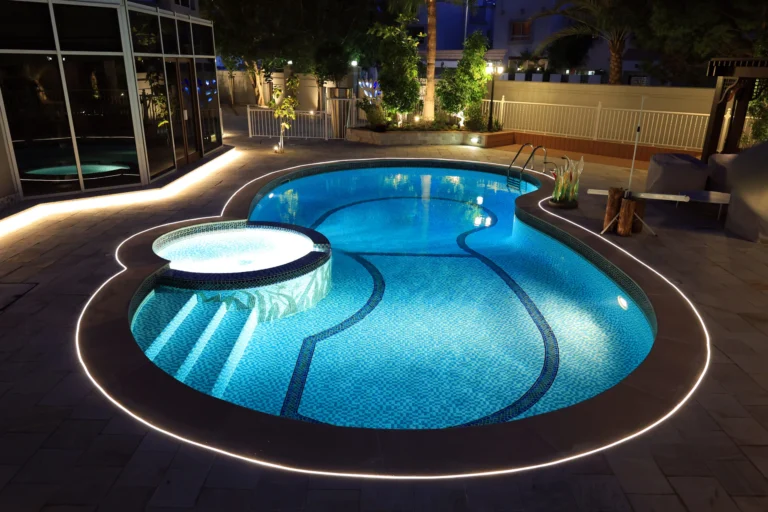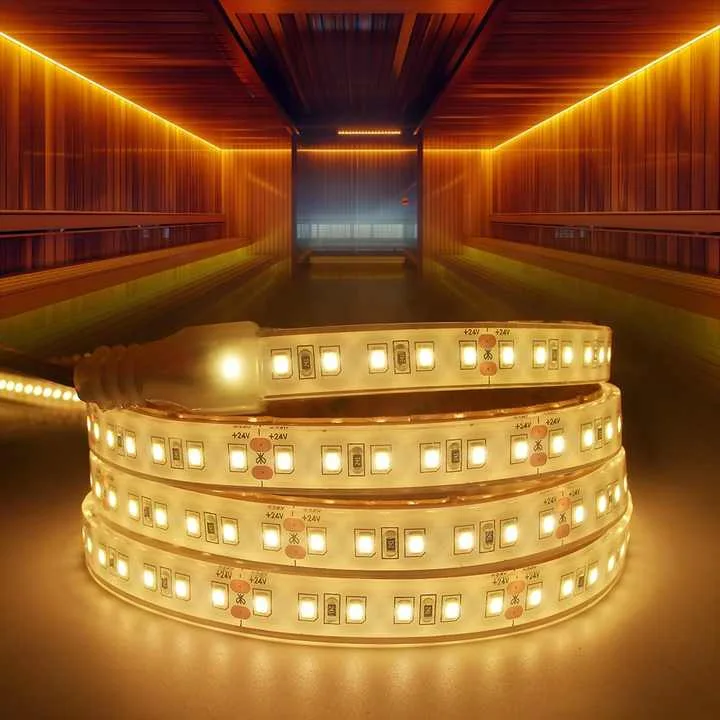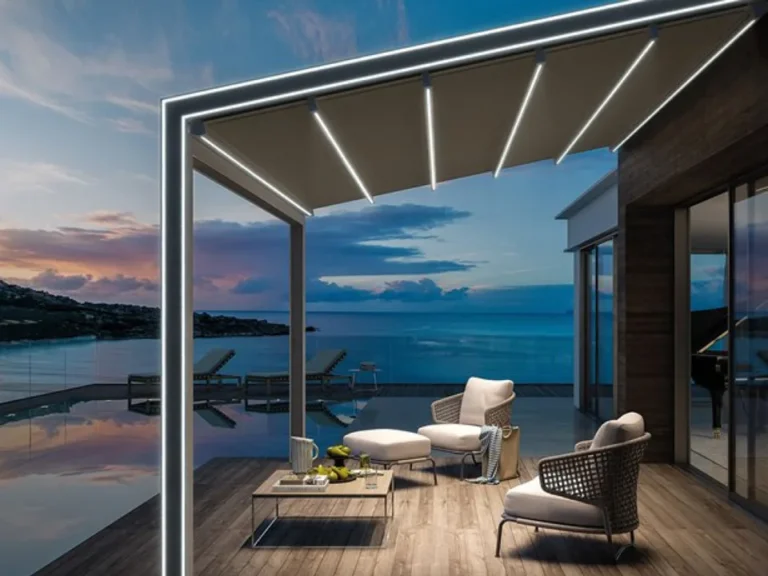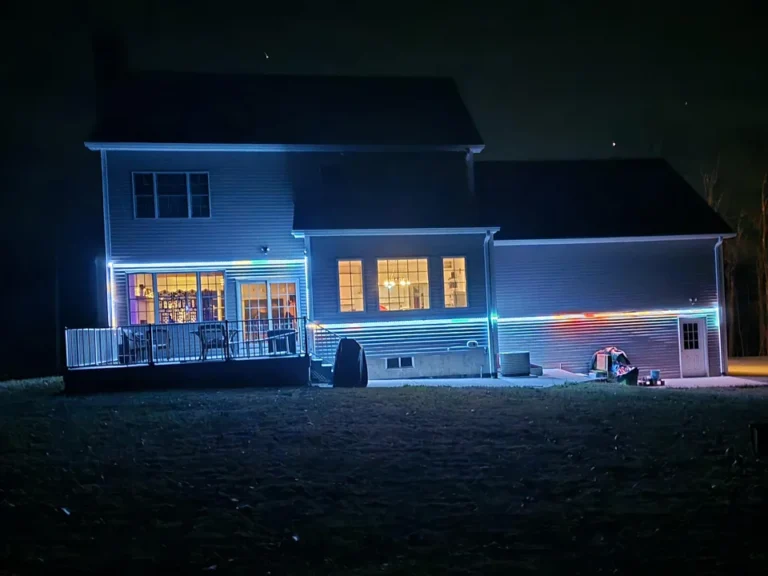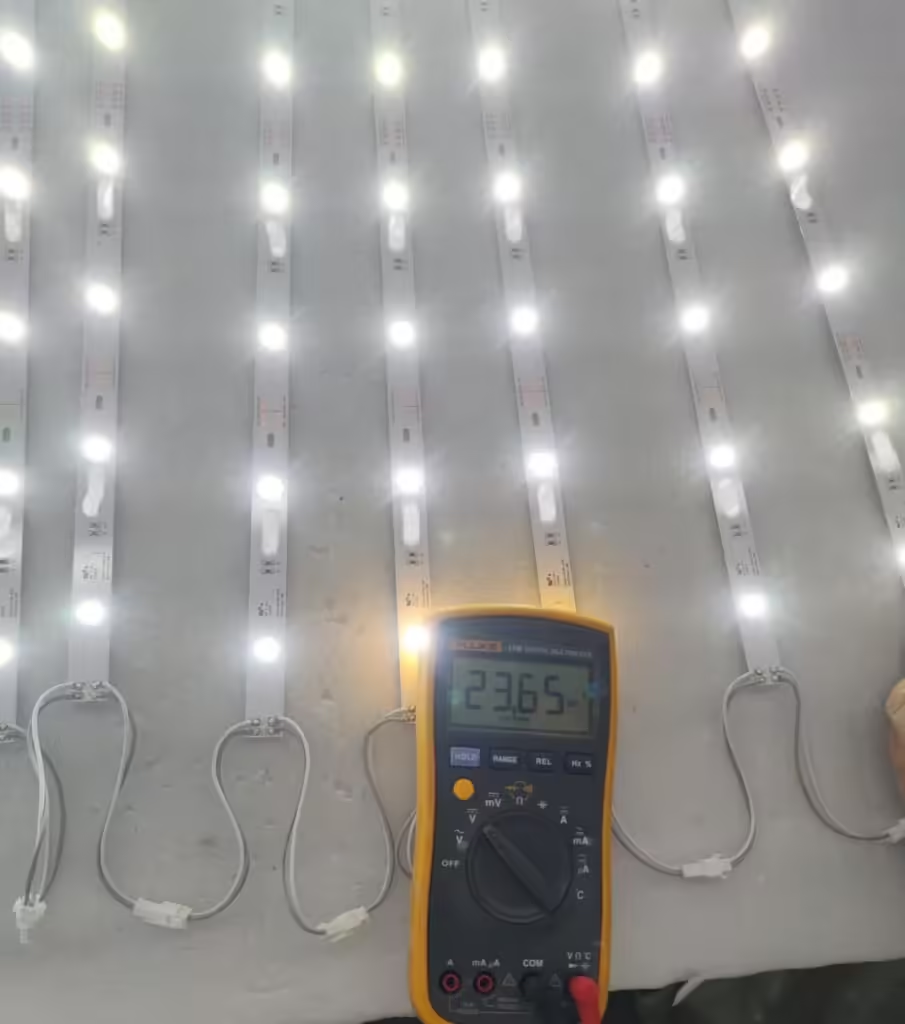Bei der Außenbeleuchtung werden LED-Streifenleuchten für ihre Flexibilität und dekorative Ausstrahlung sehr beliebt. Herkömmliche LED-Leuchtlichter sind jedoch häufig anfällig für Wasserschäden in Außenumgebungen, was zu einer verminderten Lichtleistung oder sogar zu Schäden führt. Wasserdichte LED-Streifenleuchten lösen dieses Problem effektiv. Wasserdichte LED-Lichtstreifen bieten nicht nur eine überlegene wasserdichte Leistung, sondern sorgen auch unter verschiedenen rauen Wetterbedingungen für eine stabile Beleuchtung, ohne ihre dekorativen Effekte zu beeinträchtigen.
Es gibt jedoch verschiedene Arten von wasserdichten LED-Streifen, und viele Menschen sind möglicherweise nicht gut informiert. Bei der Auswahl sollte man sich unter anderem den Preis und die wasserdichte Leistung, die beabsichtigte Nutzungsumgebung, die Sicherheit und die Beleuchtungsfarbe bewerten. Nachfolgend werde ich eine detaillierte Einführung in die relevanten Abdichtungstechniken für LED-Streifenlichter geben.
Welche Abdichtungsverfahren für COB- und SMD-LED-Streifen gibt es?
Derzeit umfassen die wichtigsten Abdichtungsverfahren für COB- und SMD-LED-Streifen Sprühbeschichtung, Tropfbeschichtung, Schlauch, Vergießen, Extrusion und Beschichtung. Jeder dieser Prozesse hat seine eigenen Eigenschaften. Schauen wir uns die Unterschiede zwischen ihnen an:
Sprühbeschichtungsprozess

Das Sprühkleberverfahren verwendet hauptsächlich eine Sprühklebermaschine, um Silikonkleber auf die Oberfläche des Lichtstreifens aufzutragen. Die Dicke der Klebeschicht ist im Allgemeinen ziemlich dünn, typischerweise etwa 30-50 Mikrometer. Aufgrund der Dünnheit der Klebeschicht hat sie nur minimale Auswirkungen auf die ursprüngliche optische Leistung des Lichtstreifens, wie Helligkeit, Farbtemperatur und Farbwiedergabeindex.
Sprühbeschichtete LED-Streifen sind LED-Beleuchtungsprodukte, die die Klebeverbindungstechnologie verbinden. Dieses Gel bietet spritzwassergeschützten Schutz und ermöglicht den sprühbeschichteten LED-Streifenprodukten eine Schutzart IP54 oder eine höhere Schutzart und verbessert so die wasserdichte, staubdichte und hohe Temperaturbeständigkeit des LED-Streifens. Diese LED-Streifen werden normalerweise in Badezimmern, Küchen, Außenbereichen oder spritzwassergeschützten Umgebungen installiert. Sie eignen sich sowohl für trockene als auch für feuchte Umgebungen wie Wohnzimmer, Küchen und Badezimmer. Sie werden nicht für den Einsatz in Bereichen empfohlen, die zu Wasserspritzern neigen.
Drop-Glue-Prozess

Der Tropfen-Klebe-Prozess beinhaltet zunächst das Befestigen des Lichtstreifens in einer geraden Linie und dann mit einer hochpräzisen Dosiermaschine, um sich entlang des Leiterplattenwegs des Lichtstreifens zu bewegen, Epoxidharz oder PU-Klebstoff auf die Oberfläche des Lichtstreifens zu injizieren. Durch die Steuerung des Klebstoffausgangs aus der Düse wird die Klebeschicht gleichmäßig aufgebracht, um die lichtemittierenden Komponenten und Schaltkreise abzudecken.
Die Dicke der Tröpfchen wird im Allgemeinen um 2 mm gesteuert. LED-Lichtstreifen, die im Drop-Coating-Verfahren hergestellt werden, erreichen eine Schutzart von IP67 oder höher, während die Flexibilität und die Wärmeableitungsleistung erhalten bleiben. Dieses Verfahren ist für feuchte Umgebungen geeignet, die Oberflächenabdichtung effektiv ermöglichen und in verschiedenen Umgebungen wie Hotels, Häusern und Büros verwendet werden können.
Die Vorteile von Drop-Leim-LED-Streifen sind einfache Bedienung und geringere Kosten, aber die Schutzart ist begrenzt (typisch IP54-IP65). Zu den Nachteilen gehören mögliche Auswirkungen auf die Wärmeableitung sowie einige Auswirkungen auf die Farbtemperatur und -helligkeit sowie die Tendenz, im Laufe der Zeit bei längerer Verwendung im Freien zu vergilben.
Hohlhülsen-Prozess

Der LED-Streifen der Hülse ist relativ einfach, wobei hauptsächlich der gesamte LED-Streifen in ein Silikon-PVC-Rohr eingeführt und dann beide Enden abgedichtet werden, um das Eindringen von Wasser durch Regen oder andere Quellen zu verhindern. Dieser Prozess ermöglicht es dem LED-Streifen, eine wasserdichte Bewertung von ungefähr IP66 zu erreichen.
Die Vorteile von LED-Lichtleisten sind eine gute Flexibilität, die Eignung für gewölbte Installationen und eine effektive Wasserbeständigkeit. Ein Nachteil ist jedoch, dass LED-Lichtstreifen mit Ärmeln nur für Regionen mit höheren Temperaturen im Süden geeignet sind. In kälteren nördlichen Regionen können die LEDs in den Hülsen während des Betriebs Wärme erzeugen. Wenn die äußere Umgebung kalt ist, können Luft und Wasser in den Hülsen oxidieren, die LEDs korrodieren oder die Leiterplatte oxidieren. Die Herstellungskosten von röhrenförmigen LED-Lichtstreifen sind relativ hoch und ihre Wärmeableitungsleistung ist leicht minderwertig, was ihre Lebensdauer beeinträchtigen kann, wenn sie über längere Zeiträume kontinuierlich verwendet wird.
Sehen Sie sich das folgende Video an, um zu erfahren, wie man einen LED-Streifen mit hohler Hülse herstellt.

Sleeve-Füllprozess

Der LED-Streifen-Hülsen-Füllvorgang beinhaltet das Verschieben einer transparenten PVC- oder Silikonhülle über die LED-Streifenoberfläche und das Mischen von zweikomponentiger organischer Silikon- oder Epoxidharz im richtigen Verhältnis, um Blasen zu vermeiden (um Lufteinschlüsse nach dem Aushärten zu vermeiden). Eine automatische Kapselungsmaschine injiziert dann das Einkapselungsmaterial entlang der Länge des Streifens gleichmäßig in die Hülse. Nach dem Aushärten bildet sich eine versiegelte Schicht in der Hülse, die die Wasserdichtigkeit und die mechanische Leistung effektiv verbessert.
Nach dem Befüllen erreicht der LED-Streifen eine IP68-Wasserdichte, was den Einsatz in Außen- oder rauer Umgebung ermöglicht. Die dichtenden LED-Streifen sind mit ihren Dichtungseigenschaften, Wetterbeständigkeit und chemischer Stabilität in anspruchsvollen Szenarien wie Außenbeleuchtung, industrieller Beleuchtung und Fahrzeugdekoration weit verbreitet und somit eine ideale Wahl für langfristige, wartungsfreie Beleuchtungslösungen.
Extrusionsprozess

Der Extrusionsprozess für flexible LED-Streifen umfasst das Erhitzen und Schmelzen von thermoplastischen Materialien (wie PVC oder Silikon), dann unter Verwendung eines Schneckenextruders, um das Material in eine Präzisionsform zu zwingen, wobei es kontinuierlich in eine streifenförmige Struktur extrudiert wird. LED-Chips und Drähte werden gleichzeitig eingebettet und eine Schutzschicht mit Coextrusionstechnologie aufgebracht. Nach dem Abkühlen und Umformen wird der Streifen auf einen Kern gewickelt. Dieses Verfahren gewährleistet die Flexibilität, Abdichtung und gleichmäßige Lichtemission der Lichtstreifen und eignet sich für eine geschwungene dekorative Beleuchtung. Es bietet auch eine hohe Produktionseffizienz und anpassbare Farben und Größen.
Die wasserdichte Bewertung von extrudierten Lichtstreifen kann dank ihrer einteiligen wasserdichten Struktur (unter Verwendung eines Extrusionsprozesses, der den Lichtkern mit Silikon umhüllt) und der hervorragenden Wetterbeständigkeit und Installationsflexibilität erreichen. Sie werden in verschiedenen Szenarien weit verbreitet und sind besonders für Anwendungen geeignet, die imprägnieren, Haltbarkeit oder komplexe Umgebungsbeleuchtung erfordern.
PECVD-Nanobeschichtungsprozess
Das Beschichtungsverfahren für LED-Streifen verwendet in erster Linie die PECVD-Nanobeschichtungs-Wasser-Beschichtungstechnologie, die durch plasmaverstärkte chemische Dampfabscheidung eine ultradünne und dichte wasserdichte Nano-Level-Beschichtung auf der Oberfläche von LED-Leuchten bildet. Die Schichtdicke kann von 1 bis 100 µm liegen. Wenn die Schichtdicke ausreichend ist, erreicht es eine Rundum-Abdichtung und Feuchtigkeitsbeständigkeit (IP68-Bewertung), ohne die Wärmeableitung der LED-Chips zu beeinträchtigen.
Die Nanobeschichtung des LED-Streifens ist farblos und transparent, sodass die Lichtdurchlässigkeit nicht beeinträchtigt wird, wodurch die Beleuchtung und die visuellen Effekte des Produkts gewährleistet werden. Die Schichtdicke ist steuerbar, mit PECVD-Beschichtungsstärken im Bereich von 1 bis 100 µm. Die Beschichtungsdicke kann zwar bis zu 0,1 μm dünn sein, so dass die Wärmeableitung der LED-Chips nicht beeinträchtigt wird.
Auswahl an wasserdichten LED-Streifen
wenn Auswahl von wasserdichten LED-Streifen, sollten die folgenden Schlüsselfaktoren auf der Grundlage der aktuellen Anforderungen der allgemeinen Anwendung berücksichtigt werden:
1. Auswahl basierend auf wasserdichter Bewertung
- IP54 LED-Streifen mit Oberflächenspray: Diese Leuchten verfügen über eine oberflächenbeschichtete Klebeschicht, die Spritzbeständigkeit, aber keine Eintauchbeständigkeit bietet. Sie eignen sich für leicht feuchte Umgebungen wie Küchenschränke und trockene Bereiche in Badezimmern.
- IP65 tropfenbeschichtete LED-Leuchtstreifen: effektive Oberflächenabdichtung, geeignet für verschiedene Umgebungen wie Hotels, Häuser und Büros.
- IP66 Hohle Silikonhülle Wasserdichte LED-Streifen: Erzielen Sie die Sprühbeständigkeit durch hohle Silikonrohre, die für halb draußene Einrichtungen wie Balkone und Innenhöfe geeignet sind, können jedoch bei längerem Untertauchen auslaufen.
- IP67/IP68 Solid Silikon-Füllung LED-Streifen (einschließlich Hülsenverguss und fester Extrusion): Mit einem vollständig geschlossenen festen Silikonprozess können diese direkt zur Verwendung (z. B. in Aquarien oder Pools) eingetaucht werden. Sie sind flexibel und lassen sich frei in Formen biegen. Sie verwenden ein 24-V-Niederspannungsdesign, um das Risiko eines elektrischen Schlags zu vermeiden.
- IP65-IP68 Nano-beschichtete LED-Streifen: Die wasserdichte Leistung dieses Prozesses ist flexibel, so dass die Schichtdicke auf die Anforderungen der Wasserdichtigkeit angepasst werden kann. In einer IP65-Umgebung kann die Beschichtungsdicke beispielsweise 0,1-0,3 µm betragen, in einer IP68-Umgebung muss die Beschichtungsdicke 1–2 µm betragen.
Weitere Informationen zu IP-Bewertungen finden Sie im Blog: Leitfaden zur wasserdichten IP-Schutzart für LED-Streifen.
2. Abgleich basierend auf Nutzungsszenarien
- Unterwasser-/Extrem feuchte Umgebungen: IP68 Solid-LED-Streifen aus Silikon sind obligatorisch, z. B. für Poolwände oder Aquarienbeleuchtung.
- Außengebäude/-dach: LED-Streifen mit IP65 oder höher werden empfohlen, die professionelle Installation erfordern, um einen elektrischen Schlag zu verhindern.
- Badezimmerspiegelschränke/Schrankboden: IP65 Niedrigspannungs-LED-Streifen sind sicherer, feuchtigkeitsbeständig und strahlen weiches Licht aus.
- Tunnel/Baubeleuchtung: Hochhelligkeitswasserdichte Lichtstreifen mit eingekapselten oder beschichteten Optionen werden bevorzugt und müssen mit Schutzgehäusen verwendet werden.
3. Spannungssicherheit
- 24V-Niederspannungs-Lichtstreifen müssen in Bereichen eingesetzt werden, in denen der menschliche Kontakt wahrscheinlich ist (z. B. Fußleisten, Möbelregale);
- Hochspannungs-Lichtbänder dürfen nur von Fachleuten an hohen oder verdeckten Orten installiert werden.
4. Leuchtende Wirksamkeit und Qualität
- Wenn ein Farbwiedergabeindex (CRI) von ≥90RA (vorzugsweise ≥95RA) erforderlich ist, um die Farbgenauigkeit sicherzustellen, sollten die COB-wasserdichten Lichtstreifen priorisiert werden.
- Wenn eine hohe Lichtkonsistenz erforderlich ist, LED-Lichtleisten mit über 120 LEDs pro Meter oder Cob Light Strips Mit über 320 LEDs pro Meter sollten Sie ausgewählt werden, um ein körniges Erscheinungsbild zu vermeiden.
- Wenn eine hohe Farbtemperaturgenauigkeit und Temperaturregelung erforderlich sind, wählen Sie spritzbeschichtete oder beschichtete LED-Streifen. Diese Arten von LED-Streifen haben eine dünnere Beschichtung, so dass die Farbtemperatur nicht abweicht und sie eine bessere Wärmeableitungsleistung aufweisen.
5. Spannungsabfallkontrolle
- 24V LED-Streifen sollten ≤20 Meter pro Streifen sein, und 12V LED-Streifen sollten ≤5 Meter pro Streifen sein. Bei längeren Längen ist eine parallele Stromversorgung erforderlich, um ein Dimmen an den Enden zu verhindern.
6. Installations- und Wartungstipps
- Verstecker: Netzteilstandorte im Voraus planen (z. B. Wartungsöffnungen für Klimaanlagen, Einbaulöcher);
- Schnittflexibilität: Bevorzugen Sie Modelle, bei denen jede LED geschnitten werden kann, um genaue Abmessungen zu erreichen.
- Materialbeständigkeit: Silikonmaterial hat eine bessere Alterungsbeständigkeit als PVC-Schläuche und verlängert die Lebensdauer im Freien um über 30%.
Zusammenfassung: Zuerst die Anforderungen an die Abdichtung bestätigen (IP-Bewertung) → Szenenspannung abgleichen → Lichteffizienzparameter (CRI/LED-Zählung/Farbtemperatur) prüfen → Installationsschema planen (Transformatorstandort + Spannungsabfallhandhabung). Beispiel: Wählen Sie für Badezimmerspiegelschränke einen 24-V-IP68-Silikon-LED-Streifen (3000K, 120 LEDs/Meter) gepaart mit einem versteckten Transformator, der in der Decke installiert ist.
Die Auswirkungen verschiedener Prozesse auf die Farbtemperatur in wasserdichten LED-Streifen
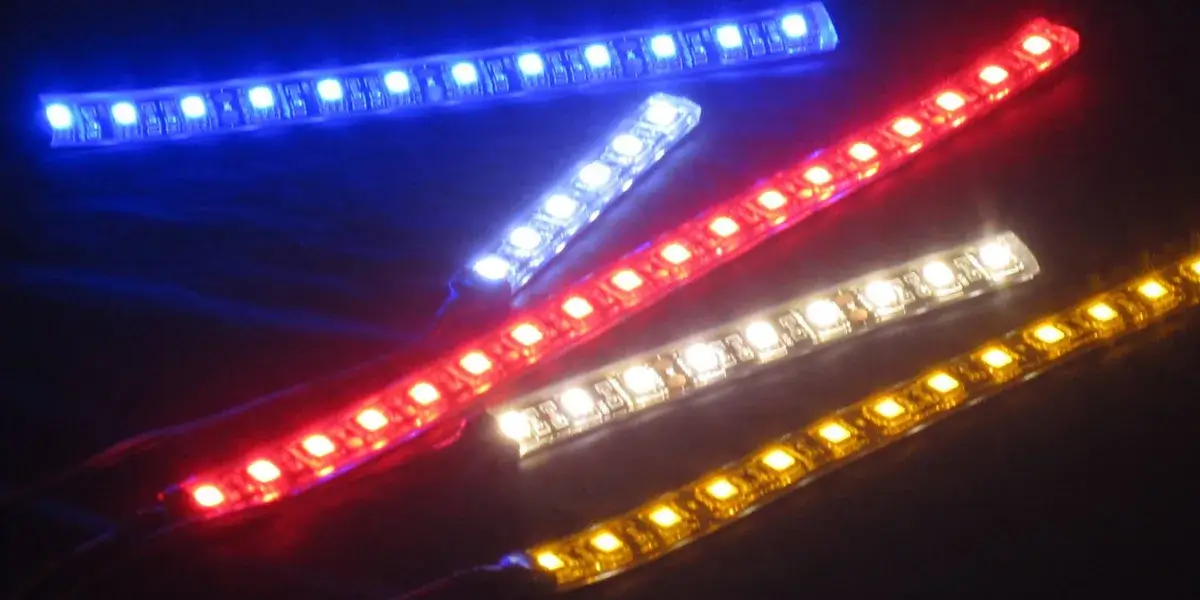
Diejenigen, die mit wasserdichten LED-Streifen vertraut sind, wissen, dass die Zugabe von verschiedenen Materialien wie Silikon, PVC und PU-Klebstoff Farbverschiebungen verursacht, wenn Licht durch diese Materialien strömt. Daher führen unterschiedliche Herstellungsverfahren zu unterschiedlichen Farbtemperaturänderungen. Wie in der folgenden Tabelle gezeigt, ist dies eine Zusammenfassung der Farbtemperatur, die verschiedenen Herstellungsprozessen entspricht, die von Sainai Optoelectronics auf der Grundlage jahrelanger Erfahrung in der Herstellung wasserdichter LED-Streifen zusammengestellt wurden, als Referenz:
| Prozesstyp | Wasserdichte Bewertung | Schutzfunktion | Farbtemperaturänderung |
| Oberflächenspray | IP54/IP65 | spritzwassergeschützt, staubdicht | Keine wesentliche Änderung |
| Oberfläche tropfenbeschichtet | IP65/IP67 | spritzwassergeschützt, staubdicht | Erhöhung um ca. 10% |
| Hohle Hülle | IP66/IP67 | Hochdruckwasserdicht, staubdicht | Erhöhung um ca. 10% |
| Ärmel | IP67/IP68 | Kurzzeitiges Eintauchen (1 Meter/30 Minuten) | Zunahme von 25%-280% |
| Extrusion | IP67/IP68 | Kurzfristiges/langfristiges Eintauchen | Erhöhung von 15-150% |
| Nanobeschichtung | IP65/IP68 | Langzeittauchen (Depth/Time customizable) | Wenig bis keine Veränderung |
Unter Bezugnahme auf die obige Tabelle müssen wir beim Entwerfen von LED-Streifen die Farbtemperatur entsprechend den Änderungen anpassen, die durch den Wasserabdichtungsprozess verursacht werden. Wenn Sie beispielsweise einen wasserdichten silikonbeschichteten COB-LED-Streifen mit einer Farbtemperatur von 3000K benötigen, ist die Auswahl eines LED-Streifens mit einer Farbtemperatur von 3000K für die Silikonbeschichtung falsch, da die resultierende Farbtemperatur um 3300K liegt. Stattdessen sollten Sie einen COB-LED-Streifen mit einer Farbtemperatur von 2700K für die Silikonbeschichtung wählen, da die Farbtemperatur für das Endprodukt um 10% ansteigen wird.
Testdaten über die Auswirkungen von Wasserabdichtungsprozessen auf die Farbtemperatur: Bitte beachten Sie den anderen Artikel des Autors: Welche Arten von LED-Streifen gibt es?
Kostenvergleich verschiedener Prozesse für wasserdichte LED-Streifen
Unter wasserdichten LED-Streifen hat der Spritzbeschichtungsprozess die geringsten Kosten, da einfache Geräte für die Präzisionsbeschichtung mit kleinem Raum geeignet sind, das Tropfbeschichtungsverfahren mäßige Ausrüstungskosten, aber eine hohe Produktionseffizienz hat, für die Produktion auf mittlerem Volumen geeignet ist, und die Spritzgieß- und Extrusionsprozesse erfordern die höchste Ausrüstungsinvestition, erreichen jedoch eine 951-TP3T-Materialausnutzung und eine 3-5-fache Steigerung der Produktionseffizienz, die für die kontinuierliche großflächige Produktion geeignet ist. Der Beschichtungsprozess hat die höchsten Gesamtkosten, wobei Geräte 1-3 Millionen Yuan kosten, eine Vakuumumgebung und einen hohen Energieverbrauch erfordern. Es können jedoch dünne Filme im Nanobereich erzielt werden, und die Kosten pro Einheit sinken mit zunehmendem Produktionsvolumen erheblich.
| Prozesstyp | Kernvorteile | Bearbeitungskosten/Meter (USD) |
| Oberflächenspray | Gleichmäßige Lichtemission, Leichtbau | 0.29 |
| Oberfläche tropfenbeschichtet | Kostengünstiger, einfacher Prozess | 0.34 |
| Hohle Hülle | Niedrige Materialkosten, hohe Arbeitskosten für die Kapselung | 0.53 |
| Ärmel | Hohe Materialkosten, schlechte Wärmeableitung | 0.76 |
| Extrusion | Hohe Kosten, hohe Schutzklasse | 0.65 |
| Nanobeschichtung | Wasserdicht, gute Wärmeableitung, steuerbare Dicke (Nanometer-Niveau) | 0.61 |
Zusammenfassung
Zusammenfassend sollte bei der Auswahl der Produktionsprozesse für wasserdichte LED-Streifen die Nutzungsumgebung (Feuchte, Temperatur), Schutzklasse, Wärmeableitungsanforderungen und Kostenbudget berücksichtigt werden.
Wenn die Anforderungen an die Abdichtung nicht strikt sind, kann das Sprühverfahren aufgrund seiner Wirtschaftlichkeit gewählt werden, bei hohen Anforderungen an die Wasserdichtigkeit kann der Extrusionsprozess ausgewählt werden, obwohl er teurer ist. Bei hohen Anforderungen an die Farbtemperatur und Wärmeableitung wird der Nanobeschichtungsprozess empfohlen. Die wasserdichte Nanobeschichtungstechnologie bietet innovative Lösungen für die Herausforderungen bei der Abdichtung und Wärmeableitung von LED-Streifen mit ihren einzigartigen Vorteilen.
Mit fortschreitenden technologischen Fortschritten und weiteren Kostenreduzierungen bietet die Zukunft vielversprechende Aussichten für LED-Streifenbeleuchtung Abdichtungs- und Wärmeableitungstechnologie, angetrieben durch die Entstehung neuer Materialien und Prozesse.

